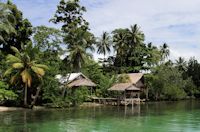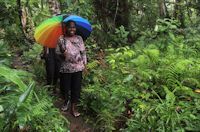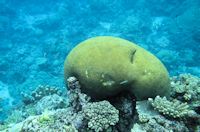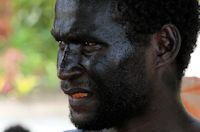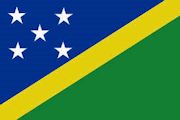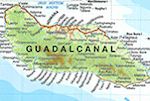Village
Life in the Solomons
Photos
of Saeragi Village
Images
of Mbabanga Village
Pictures
of Solomon Islanders
Photos
at Seghe Airfield
By
Richard Moore
While
the natural beauty of the Solomon Islands is truly outstanding
– its clear, warm waters in particular – my lasting
memories of the country are of encounters I had with
the local people.
Whether
it was being "attacked"
by tribesmen, sung
to by children in a remote kindergarten,
chatting with a stone carver at a Gizo market, or a
betelnut
seller's family near Seghe airfield, or with
kids and
their families after a game of airstrip soccer
– they all gave me a better connection to the beautiful
Solomons.
As
a traveller it is not always easy to mix with locals
– particularly if you don’t speak the local language
which, in the Solomons, is pidgin English.
And Solomon Islands men look pretty staunch and often
surly but, if you give them a wave and a smile, you
will almost always be rewarded with a massive show of
smiling white teeth and a wave back.
People in the Solomons I found to be lovely.
They
are quiet, almost shy, but it is worth making the effort
to reach out.
The kids are really curious about visitors and with
a bit of coaxing you can get them to chat about their
schools and what they do.
Near
the airstrip at Seghe, on the south coast of New Georgia,
we were sheltering from the hot sun on a shady verandah
and got to talking with a betelnut seller.
Betelnuts
are chewed by seemingly most of the population and stallholders
can make a good living selling them. She had five children
– four girls and a boy – and the youngsters became quite
chatty with a bit of prompting I
took some photos and they were delighted to see themselves
on the back of my camera.
Later
I crossed the grass strip because I saw some lads taking
penalty kicks with a very old soccer ball. I couldn’t
resist and asked if I could join in.
The
young guns, who ranged in age between about 4 and 10,
no doubt thought I’d be an easy victim and they’d score
lots of goals. (I didn’t let on I had been a goalkeeper
at quite a high level).
After about 10 minutes they were very disappointed they
didn’t get the ball past me but still let me chat with
them on a wooden deck and their mum joined in our yakking
session.
Possibly
the best interaction, though, was at the village of
Saeragi on Gizo Island when, after our visit to the
village, we cooled off by jumping into glorious waters
with a group of local kids.
They
no doubt thought we were quite mad, but it was an absolute
hoot and the delight they had at my “bombing” lessons
had us all cracking up.
Approaching
Saeragi
only an hour or so before it was hard to focus on anything
other than the picturesque shoreline of magnificent
trees and impressive native buildings dotted along it.
Unless
it was the extraordinary colour of the water – a rich
green-blue that called for you to dive in and cool yourself
on a hot, humid Solomon Islands day.
Saeragi
is on the northern tip of Gizo Island in the Solomons'
Western Province.
We
had gone by a local boat around coasts of palm trees
and jungle, steering in between small, verdant islands
on our journey from Gizo town. The sheltered waters
were gentle under a blue sky speckled with fluffy clouds.
Rounding the final corner we waved back to the friendly
villagers who were cooling off in the calm waters and
the host of kids spilling on to the golden sands. We
steered in towards shore and my focus was entirely on
framing shots within my viewfinder.
Someone said a conch sounded, I hadn't noticed, but
the cries of my female colleagues alerted me to something
out of the ordinary and so I stood up and started shooting
– images that is.
We
were being rushed by black-painted Islanders who were
armed with spears and axes. They were yelling, presumably
a challenge, and charging our boat.
It was both surprising and exciting and had it been
a real attack we would have been very quickly in trouble
and, in times long gone, possibly featured on the menu.
While in the past they were headhunters, to call today’s
villagers of Saeragi friendly is to do them a disservice
– they are delightfully welcoming.
Once
ashore we were given crowns of fragrant flowers and
sweet-smelling floral necklaces before being treated
to the refreshing flavour of the water from freshly
opened young coconuts.
The leader of the young warriors greeted us and explained
what would happen during our visit to his village. While
fearsome with axe in hand he was new to the speeches
game, but his presentation was well done and we were
honoured to be welcomed into Saeragi.
We had the various woven – and very attractive - baskets
explained to us and we all commented on how their swirling
construction differed so elegantly from the usual interlocked
weaving from other parts of the world.
Suddenly
there was another commotion as some of the local children
reacted with excitement as one of our group showed them
images of themselves on an iPad.
And
it has to be said these kids are cute. Big eyed, dark
skinned, white toothed, cheeky and delightful little
beings.
Then
it was back to official proceedings.
First up we were shown how the villagers started fire
rubbing sticks and then using coconut husk to accept
the heat and start the flame.
Hard,
skilled work that doesn't come easy to First World hands.
It's even less easy in front of laughing little ones
who clearly expect visitors to be as good as villagers
in the fire-starting business.
Next came a demonstration of how to de-husk a coconut
with a sharpened stake. Easy when you have done it many
times, not so much for newbies. Mind you, if you end
up like Tom Hanks in Cast Away it could be a lifesaver.
I'm
a bit of a dab hand at opening coconuts with the back
of a blade – having learned it in the Cook Islands –
but my skills were never called upon at Saeragi.
My ability to eat, however, was - after both an interesting
lesson in how Solomon Islanders cook via a heated rock
oven covered in leaves, as well as and traditional dancing.
We
were treated to three dances – a welcome, party dance,
a best mates knees-up and a tribal effort that warriors
would do before setting off on a head-hunting raid.
That was both fascinating and little bit scary.
Possibly
more worrying than I will admit to with intimidating
noises and cadence as well as a snake-like choreography.
It
was after our very tasty lunch we took five minutes
– well, five island minutes (about half an hour) – to
cool off at a pier in front of what we took to be an
open-air school.
The kids there were delighted the foreigners were ready
to swim with them and we all really enjoyed the chance
to be part of their environment.
It
has to be said that the children were driven to peals
of laughter by the big white guy landing two spectacular
bombs that sent water splashing the height of the trees.
Well,
not really, but they were impressive!
After
30 minutes in the water with the kids it was time to
return to Gizo and we did so reluctantly after what
was a really enjoyable time with the villagers of Saeragi.
The next day we had a much more intimate encounter at
a kindergarten in the remote village on Mbabanga Island
about 20 minutes by longboat from Gizo.
It was cute, but slightly awkward, and yet so endearing
that meeting those children became one of the highlights
of our event-filled visit to the Solomons.
Through
intermittently heavy rain we had walked for about 20
minutes through jungle and tall coconut palm plantations
to get to the home of 300 islanders – a clean and well
laid out collection of pole huts and buildings made
from local hard wood and thatched palm fronds. Some
homes had tin roofs using rusting corrugated iron.
We
went to Mbabanga
to see life as it is for most Solomon Islanders who
live away from the big cities.
It
was basic, very basic.
Fresh
water comes from tanks collecting rainwater and obtained
through a PVC pipe centrally placed like a modern-day
well.
And
it probably wasn’t the right day to come as the skies
were grey, the sea was grey and well, it was humid and
very wet. But, when you are on a tight schedule, you
need to get out and about in all weathers and worry
later about finding a good cloth to dry off the camera
gear.
The
kindy was set in a thatched building with a split-level
floor. On one side was a raised sandy area, while the
classes were held on the lower area on woven frond matting.
It was cool and decorative. The bottom half of the class’
walls was rough wood paneling and the top sections open
to the elements, although sturdy wire grills served
as places to hang class work.
We
were welcomed at the door by Jacinta, the kindergarten
teacher, and given flower headwear by three of the little
kids. The flowers were definitely not my cup of tea,
but to refuse the offering would be rude and they did
smell beautiful.
Then
we were treated to a song as the class introduced themselves
by each one singing: “My name is …. And I love the Lord.”
There
were 18 kids in the kindy class, although Jacinta confided
that a number of them were younger brothers and sisters
who came along to join in. They were aged between three
and five, dressed in a variety of clothes and colours
and all had big dark eyes.
We
took photos and – as a really good icebreaker we discovered
while touring the islands – we showed the class the
images on our digital devices.
They crowded around and their reactions were fun – all
were delighted to see themselves on an iPad or back
of my camera.
It was probably the first time in their lives they’d
seen pictures of themselves.
Once
Jacinta restored a bit or order – mainly among we visitors
– the class sang us some songs and did some dances.
The
girls were very shy and did a cute, but unwiggly, version
of a native dance. The lads – boisterous even at that
age – did an energetic dance I took to be the local
challenge.
Then,
dancing complete, it was time to go.
We stood and my female travelling companions were farewelled
by the kids but the young fellow designated to be my
“Goodbye Guy” burst into tears saying he was scared
of me.
Hardly surprising as I was twice the size of the men
in the village and my shade of slighty-tanned pink I
guess was a bit of a rarity in these parts.
As
are children’s books and so I made a mental note that
upon my return home I would delve into my storage unit
and get a collection of suitable titles from the ones
I used to read to my kids and send them over to Jacinta
and her charges.
To
me they only contain memories, but for the island children
they could open their eyes to a different world … much
as the kids did for me.
